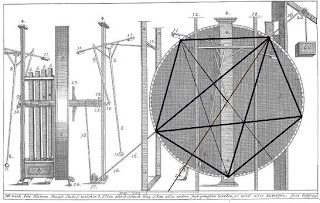Bessler's belief in God seems to have been a constant theme throughout his life and I wondered at one time if all his loudly proclaimed faith was genuine, but latter events seem to confirm its validity.
Johann Bessler attributed his success to his own determination to succeed - and more importantly, to God. This fervent religious belief is something I have tried to understand without success. I can't help that I'm not a believer, in fact I am an agnostic atheist. One of the best definitions of such, is that of Robert Flint, in his Croall Lecture of 1887–1888 (published in 1903 under the title Agnosticism).
"The atheist may however be, and not unfrequently is, an agnostic. There is an agnostic atheism or atheistic agnosticism, and the combination of atheism with agnosticism which may be so named is not an uncommon one.
If a man has failed to find any good reason for believing that there is a God, it is perfectly natural and rational that he should not believe that there is a God; and if so, he is an atheist... if he goes farther, and, after an investigation into the nature and reach of human knowledge, ending in the conclusion that the existence of God is incapable of proof, cease to believe in it on the ground that he cannot know it to be true, he is an agnostic and also an atheist – an agnostic-atheist – an atheist because an agnostic... while, then, it is erroneous to identify agnosticism and atheism, it is equally erroneous so to separate them as if the one were exclusive of the other.."
So when Bessler awoke from his strangely invigorating dream which gave him the confidence to carry on to success, he attributed it to God. He would never have considered that it might have been intuition. Intuition may be defined as "understanding or knowing without conscious recourse to thought, observation or reason. Some see this unmediated process as somehow mystical while others describe intuition as being a response to unconscious cues or implicitly apprehended prior learning." Dr. Jason Gallate & Ms Shannan Keen BA.
Many, if not all of us, have experienced that moment of revelation in the night or upon waking which seems to provide a light at the end of the tunnel, something which might lead to success or at least progress. This revelation is, in my opinion, the result of "understanding or knowing without conscious recourse to thought, observation or reason", or to put it another way, the subconscious has continued to worry at the problem and supplied its solution upon waking. Dreams are often recalled upon waking and yet vanish in the light of a later dawn. Our subconscious is closer to our waking minds at that moment of transition, when we finally awaken or if we surface momentarily during the night and it is then we can connect, however briefly, with it.
I have no wish to impugn other people's religious convictions, and I have sought to understand them over the years, but in the end one's beliefs are a matter of personal conviction which does not require explanation to anyone else. To me there is an odd dichotomy between religion and science. Many top scientists as well as the vast majority of the world's population follow a religion. But how is it that on the one hand those experts teach us that Bessler's wheel was impossible, because of their rational, objective, non-magical view of the world - and yet on the other hand they state with absolute authority and sincerity their utter belief in the existence of God with no evidence whatsoever other than their subjective experience. Surely two such differing views must be mutually exclusive? How can rational scientists state unequivocally that Bessler's wheel was impossible then go to church on Sunday and 'pray' or talk to a being whose very existence is unknowable.
I read that Science is natural and that:-
- It explains the existence & order of the universe & human consciousness.
- It is rational, fact-based, objective & non-dogmatic.
- It is antithetical to sectarianism, dogmatism, intolerance & violence.
- It does not indulge in magical thinking.
- It deals with human reality, which is the material world.
- It is progressive, evolving as we evolve.
- It is self-correcting, acknowledges its mistakes & moves on.
On the other hand I read that Religion is not only subjective, it’s irrational, and therefore cannot be a source of truth for the following reasons:-
- It was invented by man.
- It misrepresents the origins of man & cosmos and represses human intellect.
- It is irrational, dogmatic, subjective.
- It gives rise to sectarianism, disunity, intolerance, repression & violence.
- It indulges in magical thinking.
- It combines servility & solipsism.
- It represents an anachronistic, Bronze Age philosophy.
And let's not ignore the common man, if he will forgive me for referring to him (or her) thus? How many believe in ghosts, good luck, superstition, life after death, psychic phenomena etc, etc? None of these things are proven and yet people would rather believe in some subjective absurdity that they have been persuaded is real than a well documented machine whose only failing was that it appeared to conflict with the laws of science as laid down by those God-fearing men of 300 years ago.
On the other side of the coin, I think there is a strong possibility that those revelations, I mentioned easrlier, that we experience in the night are sometimes proven correct and sometimes turn out to be an example of apophenia. Remember that definition - the perception of patterns, meanings, or connections where none exists? Is religion based on seeing patterns where none exist; seeing God's hand in places or events where a more mundane explanation which did not require such divine intervention would suffice.
JC
10a2c5d26e15f6g7h10ik12l3m6n14o14r5s17tu6v5w4y4-3,’.

.jpg)







